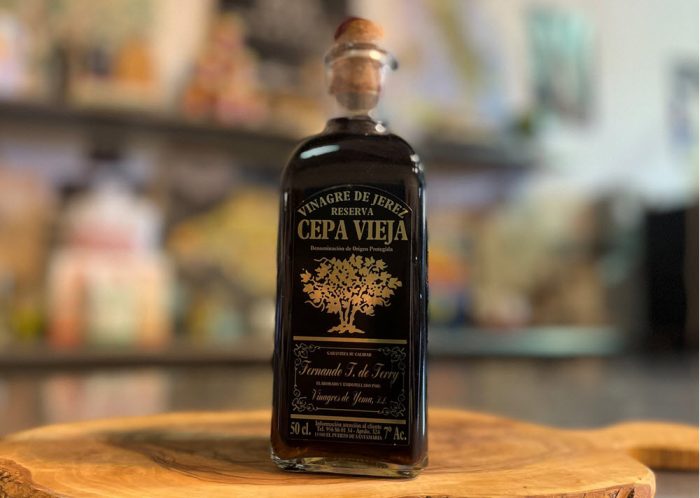Sherry Vinegar, which is wine vinegar made from sherry, is much more than a simple seasoning. It’s a cornerstone of Spanish cuisine, famed for its rich, complex flavours that add depth to any dish it graces. This culinary gem is steeped in history, tradition, and craftsmanship, making it an indispensable ingredient for gourmands worldwide. In this article, we delve into what makes Sherry vinegar truly special, its production process, and how to use it in your cooking.
Known as Vinagre de Jerez in Spanish, sherry vinegar is traditionally made in Spanish province of Cadiz, more specifically in the triangular area between the city of Jerez de la Frontera and the towns of Sanlúcar de Barrameda and El Puerto de Santa María.

Sherry vinegar is celebrated for its unique taste profile. It offers a harmonious balance of sweet and sour, with notes of nuts, vanilla, and dried fruit. Its acidity is well-rounded, and the flavour is complex, with a long finish that leaves a pleasant aftertaste.
The versatile nature of Sherry vinegar makes it suitable for a wide range of culinary applications. It enhances the flavours in salads and marinades, adds a tangy twist to soups and stews, and pairs exceptionally well with seafood and meat dishes. Its refined yet robust flavour profile also makes it a go-to ingredient for deglazing pans or creating reductions. A vinaigrette made from sherry vinegar is considerably more flavourful than vinaigrette made from standard white wine vinegar, and the flavour profile will be both deeper and more complex. Sherry vinegar is used extensively not only in its native Spain but also in French cuisine.
If you want to try a tradtional Spanish dish that highlights vinagre de jereze, I recommend Riñones al Jerez, which is lambs kidneys served with a sauce made from both sherry vinegar and sherry wine.
Sherry vinegar has been granted its own Denominación de Origen, which is protected by Spanish law and EU law. This designation means that any vinegar labeled as Sherry vinegar must come from the Sherry Triangle Area in Spain, and production must follow specific standards. The production and quality of sherry vinegar is monitored and controlled by the Consejo Regulador.
In the United States, a product must fulfill certain requirements to be sold as Vinagre de Jerez. This includes being aged in Americna oak for at least 6 months, and the aging must take place within the abovementioned Sherry Triangle. The vinegar must also have a minimum of 7 degrees acidity.
Making vinegar from sherry is closely linked to the tradition of making of sherry wine in and around the city Jerez de la Frontera in Andalusia, Spain. Sherry is a fortfied wine made from white grapes grown near Jerez. After fermentation of the base wine is complete, it isfortified with grape spirit to increase the alcohol content.
In the past, it was considered a failure of the wine in a sherry bodega underwent acetic fermentation and turned into vinegar. A barrel of sherry that developed in this way would quickly be removed from the bodega to prevent contamination, and the empty barrel would not be used for storing wine again. Instead of throwing out the sherry vinegar, some bodega owners would give it away to staff and or sell it cheaply at the bodega door.
It was not until the 1950s that sherry vinegar began to be seen and marketed as a product in its own right. This encouraged producers to deliberately make sherry vinegar, and carefully age their sherry vinegars in ways similar to those developed for wines and brandies.
The production of Sherry vinegar is a labor-intensive process. It begins with the fermentation of sherry wine. The wine then undergoes a process known as aging in soleras. This age-old method involves storing the vinegar in a series of cascading barrels, with a small amount of younger vinegar added to older stocks. This blending process imparts sherry vinegar with its characteristic complex flavor profile. Most sherry vinegars are aged using the same solera system as the sherry wines and Brandy de Jerez.
There are three primary categories of Sherry vinegar: Vinagre de Jerez, Vinagre de Jerez Reserva, and Vinagre de Jerez Gran Reserva. They differ in their aging period, with the Gran Reserva variant aged for at least ten years, providing a more profound and intense flavor
Different grapes can be used to produce different styles of sherry vinegar. The classic grape for making sherry wine is Palomino, and both young Palomino sherry and aged Palomino sherry have become popular for sherry vinegar production. The Palomino grape can be divided into sub-varieties, of which the Palomino Fino is the principal grape for sherry production.
Some producers are offering a different style sherry vinegar made from the grape al Pedro Ximénez. The wines used are usually very sweet and this sweetness is noticable in the vinegar too. To increase the sweetness even more, some producers add a small amount of pure Pedro Ximénez wine to the vinegar.
Much more unusual, sherry vinegar is sometimes produced from grapes of the Muscat family.
Sherry vinegar is not just an ingredient—it’s a taste adventure, a voyage into the heart of contemporary Spanish cousine. Its complex flavors make it a staple in many gourmet kitchens. Whether you’re a seasoned chef or a home cooking enthusiast, incorporating Vinagre de Jerez into your culinary repertoire will allow you to explore new dimensions of taste and sophistication.